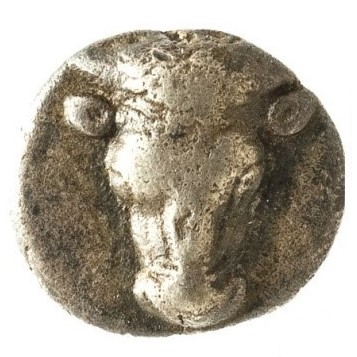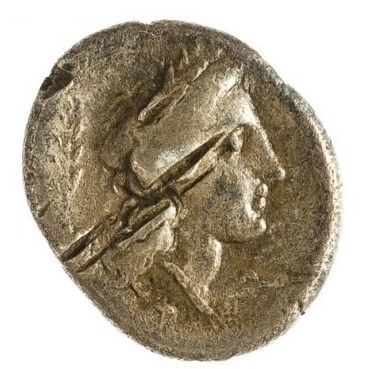Title: Triobolon (hemidrachmon) of Phokis - 1980.04
Acquisition number: 1980.04
Author or editor: Douglas Kelly
Culture or period: Classical Greece.
Date: c. 355 - 346 BC.
Material: Metal - Silver
Object type: Coins - Greek
Dimensions: 14mm (w)
Origin region or location: Greece
Origin city: Delphi.
Display case or on loan: 5
Keywords: Coin, Greek, triobolon, hemidrachmon, Phokis, Delphi, Apollo, Third Sacred War
Sylloge Nummorum Graecorum, Copenhagen, The Royal Collection of Coins and Medals, Danish National Museum, repr. edn (West Milford, NJ, 1981-), 120.
Numismatica Ars Classica, The BCD Collection: Lokris-Phokis (Auction 55 [8 October 2010] Numismatica Ars Classica, Zurich-London, 2010), 280.3.
R.T. Williams, The Silver Coinage of the Phokians (London, 1972).
1980.04
Triobolon (hemidrachmon) of Phokis
Silver, 2.55 g. 14 mm. c. 355-346 BC.
Obv.: Head of a bull facing.
Rev.: Head of Apollo of Delphi, wreathed, with laurel branch to left, test cuts to reverse.
The Phokians inhabited the region immediately to the north, east and south of Delphi. From about the end of the 6th century BC their twenty or more poleis had been united in a federal state. This coin was minted by the Phokian koinon (federation), most likely at Delphi, during the Third Sacred War (356–346 BC). This war arose when certain Phokian aristocrats, under attack from Phokis’ enemies in the Delphic Amphiktyony (the religious league which controlled the sanctuary) convinced their fellow Phokians to seize and hold Delphi, to which the Phokians believed they had an ancestral claim.
During the war, the Lokrians, Boiotians and Thessalians tried unsuccessfully to dislodge the Phokians from Delphi. It was left to Philip II of Makedonia to end the war in 346. In the meantime, the Phokians had become a great power by melting down many of the treasures at Delphi and hiring mercenaries. To do this they minted coins with the head of Apollo, the main god at Delphi, replacing Artemis who had previously featured on Phokian coins.
By the end of the war the Phokians had reputedly ‘borrowed’ from Apollo the equivalent of 10,000 talents of silver, 4000 talents of which came from Apollo’s golden dedications (Diodoros 16.56.6). Only a relatively small number of the resulting coins survive. No doubt after the war their sacrilegious associations encouraged people to melt them down. The neighbouring state of Opountian Lokris piously collected all the Phokian silver coins they could find and melted them down for a giant silver hydria (water-jar) dedicated to Apollo at Delphi (Plutarch, ‘On the Oracles at Delphi’, Moralia 401F).
The triobol (three-obol piece), equal to a quarter of a stater, was the most common silver coin issued by Phokis. The bull’s head seems to have been the badge of the Phokian state, perhaps chosen more for its heraldic associations (cf. 1990.01 Gela) than for any reference to Phokian cattle-farming. Like the Corinthian coins,1967.15 and 1973.27, this coin is unusual in having the head of the god on the reverse rather than the obverse.
The presence of an olive branch to the left of Apollo suggests, it has been argued, that this coin was minted under Philomelos, the Phokian general who seized Delphi in 356 but was killed at the battle of Neon in 355. Later coins replaced the olive branch with a lyre.
Sylloge Nummorum Graecorum, Copenhagen, The Royal Collection of Coins and Medals, Danish National Museum, repr. edn (West Milford, NJ, 1981-), 120.
Numismatica Ars Classica, The BCD Collection: Lokris-Phokis (Auction 55 [8 October 2010] Numismatica Ars Classica, Zurich-London, 2010), 280.3.
R.T. Williams, The Silver Coinage of the Phokians (London, 1972).

